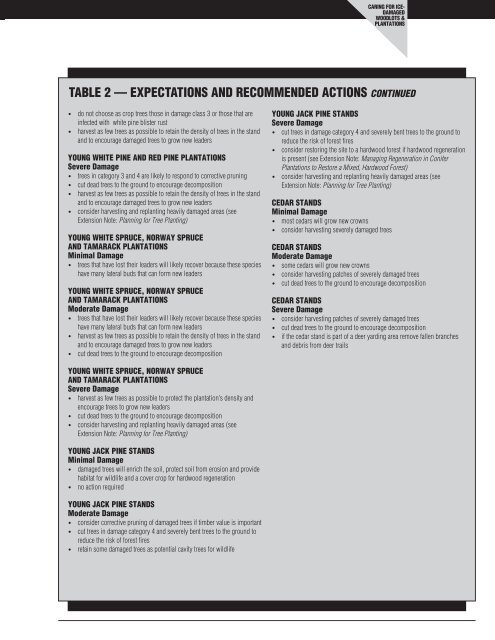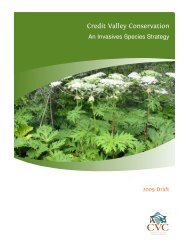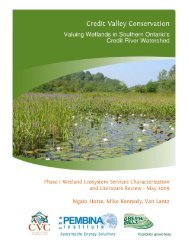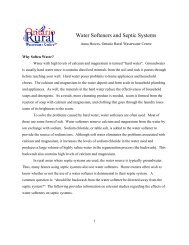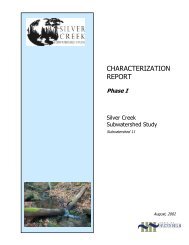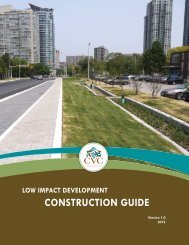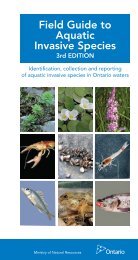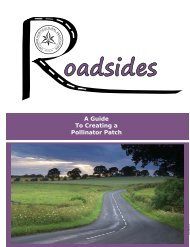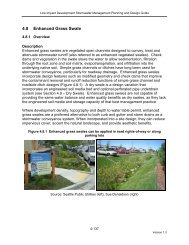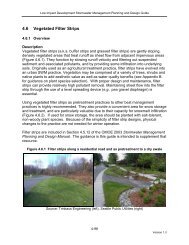caring for ice-damaged woodlots and plantations - LandOwner ...
caring for ice-damaged woodlots and plantations - LandOwner ...
caring for ice-damaged woodlots and plantations - LandOwner ...
You also want an ePaper? Increase the reach of your titles
YUMPU automatically turns print PDFs into web optimized ePapers that Google loves.
CARING FOR ICE-DAMAGEDWOODLOTS &PLANTATIONSTABLE 2 — EXPECTATIONS AND RECOMMENDED ACTIONS CONTINUED• do not choose as crop trees those in damage class 3 or those that areinfected with white pine blister rust• harvest as few trees as possible to retain the density of trees in the st<strong>and</strong><strong>and</strong> to encourage <strong>damaged</strong> trees to grow new leadersYOUNG WHITE PINE AND RED PINE PLANTATIONSSevere Damage• trees in category 3 <strong>and</strong> 4 are likely to respond to corrective pruning• cut dead trees to the ground to encourage decomposition• harvest as few trees as possible to retain the density of trees in the st<strong>and</strong><strong>and</strong> to encourage <strong>damaged</strong> trees to grow new leaders• consider harvesting <strong>and</strong> replanting heavily <strong>damaged</strong> areas (seeExtension Note: Planning <strong>for</strong> Tree Planting)YOUNG WHITE SPRUCE, NORWAY SPRUCEAND TAMARACK PLANTATIONSMinimal Damage• trees that have lost their leaders will likely recover because these specieshave many lateral buds that can <strong>for</strong>m new leadersYOUNG WHITE SPRUCE, NORWAY SPRUCEAND TAMARACK PLANTATIONSModerate Damage• trees that have lost their leaders will likely recover because these specieshave many lateral buds that can <strong>for</strong>m new leaders• harvest as few trees as possible to retain the density of trees in the st<strong>and</strong><strong>and</strong> to encourage <strong>damaged</strong> trees to grow new leaders• cut dead trees to the ground to encourage decompositionYOUNG JACK PINE STANDSSevere Damage• cut trees in damage category 4 <strong>and</strong> severely bent trees to the ground toreduce the risk of <strong>for</strong>est fires• consider restoring the site to a hardwood <strong>for</strong>est if hardwood regenerationis present (see Extension Note: Managing Regeneration in ConiferPlantations to Restore a Mixed, Hardwood Forest)• consider harvesting <strong>and</strong> replanting heavily <strong>damaged</strong> areas (seeExtension Note: Planning <strong>for</strong> Tree Planting)CEDAR STANDSMinimal Damage• most cedars will grow new crowns• consider harvesting severely <strong>damaged</strong> treesCEDAR STANDSModerate Damage• some cedars will grow new crowns• consider harvesting patches of severely <strong>damaged</strong> trees• cut dead trees to the ground to encourage decompositionCEDAR STANDSSevere Damage• consider harvesting patches of severely <strong>damaged</strong> trees• cut dead trees to the ground to encourage decomposition• if the cedar st<strong>and</strong> is part of a deer yarding area remove fallen branches<strong>and</strong> debris from deer trailsYOUNG WHITE SPRUCE, NORWAY SPRUCEAND TAMARACK PLANTATIONSSevere Damage• harvest as few trees as possible to protect the plantation’s density <strong>and</strong>encourage trees to grow new leaders• cut dead trees to the ground to encourage decomposition• consider harvesting <strong>and</strong> replanting heavily <strong>damaged</strong> areas (seeExtension Note: Planning <strong>for</strong> Tree Planting)YOUNG JACK PINE STANDSMinimal Damage• <strong>damaged</strong> trees will enrich the soil, protect soil from erosion <strong>and</strong> providehabitat <strong>for</strong> wildlife <strong>and</strong> a cover crop <strong>for</strong> hardwood regeneration• no action requiredYOUNG JACK PINE STANDSModerate Damage• consider corrective pruning of <strong>damaged</strong> trees if timber value is important• cut trees in damage category 4 <strong>and</strong> severely bent trees to the ground toreduce the risk of <strong>for</strong>est fires• retain some <strong>damaged</strong> trees as potential cavity trees <strong>for</strong> wildlife


